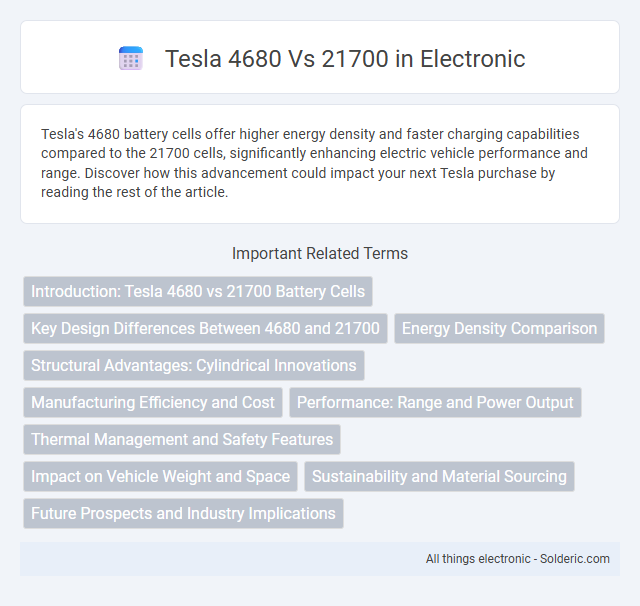Tesla's 4680 battery cells offer higher energy density and faster charging capabilities compared to the 21700 cells, significantly enhancing electric vehicle performance and range. Discover how this advancement could impact your next Tesla purchase by reading the rest of the article.
Comparison Table
| Feature | Tesla 4680 | Tesla 21700 |
|---|---|---|
| Dimensions | 46mm diameter, 80mm length | 21mm diameter, 70mm length |
| Capacity | Approximately 3000-3500mAh | Approximately 4800-5000mAh |
| Energy Density | Higher energy density due to larger size and improved chemistry | Lower energy density compared to 4680 |
| Power Output | Higher power output for improved performance | Lower power output relative to 4680 |
| Cooling | Tabless design improves thermal management | Traditional tab design; less efficient cooling |
| Manufacturing | Advanced manufacturing with reduced complexity | Established manufacturing process |
| Application | Used in Tesla Model Y, upcoming models | Used in Tesla Model 3, Model Y (older versions) |
| Cost | Potentially lower cost per kWh due to scale and design | Higher cost per kWh compared to 4680 |
Introduction: Tesla 4680 vs 21700 Battery Cells
Tesla 4680 battery cells offer a larger form factor with a diameter of 46mm and a height of 80mm, compared to the 21mm diameter and 70mm height of the 21700 cells. The 4680 cells deliver higher energy capacity, improved thermal management, and increased power output, resulting in enhanced vehicle range and performance. Innovations in the 4680 design, such as tabless electrodes and faster manufacturing techniques, contribute to reduced production costs and greater efficiency over the 21700 cells.
Key Design Differences Between 4680 and 21700
The Tesla 4680 battery features a larger 46mm diameter and 80mm height compared to the 21700's 21mm diameter and 70mm height, allowing for greater energy density and improved thermal management. The 4680 uses a tabless electrode design that reduces internal resistance and enhances cooling efficiency, while the 21700 relies on traditional tab-based construction. Your vehicle's performance and range benefit significantly from these key design improvements in the 4680 cell.
Energy Density Comparison
Tesla's 4680 battery cells offer a significant increase in energy density compared to the 21700 cells, boasting approximately 20% higher capacity due to their larger size and improved structural design. The 4680 cells feature a tabless design that enhances thermal management and efficiency, enabling more power output while maintaining safety. If you seek longer driving range and faster charging in your Tesla vehicle, the advanced energy density of the 4680 cells delivers a meaningful upgrade over the older 21700 format.
Structural Advantages: Cylindrical Innovations
Tesla's 4680 battery cells offer significant structural advantages over the 21700 cells through their larger size and tabless design, which enhances mechanical integrity and thermal management. The cylindrical innovation in the 4680 allows for greater energy density and improved heat dissipation, reducing internal resistance and enhancing overall battery longevity. These advancements contribute to stronger vehicle frames by integrating cells directly into the chassis, increasing structural rigidity while reducing weight.
Manufacturing Efficiency and Cost
Tesla's 4680 battery cells significantly improve manufacturing efficiency by featuring a larger format that reduces the number of cells needed per pack, streamlining assembly and lowering labor costs. The new tabless design of the 4680 cells enhances thermal management and simplifies production processes, contributing to a reduction in the overall cost per kilowatt-hour. In contrast, the older 21700 cells require more complex assembly and higher material usage, resulting in increased manufacturing time and higher production expenses.
Performance: Range and Power Output
Tesla's 4680 battery cells deliver significantly improved performance compared to the 21700 cells, offering higher energy density that boosts vehicle range and reduces weight. These cells enable increased power output, resulting in faster acceleration and enhanced overall driving dynamics. Your electric vehicle equipped with 4680 cells can achieve longer trips on a single charge while benefiting from superior power efficiency.
Thermal Management and Safety Features
Tesla 4680 cells showcase enhanced thermal management due to their larger size and tabless design, which reduces heat buildup and improves cooling efficiency compared to the 21700 cells. The improved thermal regulation in 4680 batteries lowers the risk of thermal runaway, supporting safer operation in high-demand applications such as electric vehicles. Your Tesla's 4680 pack incorporates advanced safety features including better cell spacing and reinforced structural integration, significantly enhancing overall battery safety.
Impact on Vehicle Weight and Space
The Tesla 4680 battery cells offer a significant reduction in vehicle weight by increasing energy density compared to the 21700 cells, allowing for lighter battery packs without compromising range. Their larger format enhances space utilization within the battery pack, enabling more efficient packaging and freeing up interior vehicle volume for improved design flexibility. This optimization contributes to overall vehicle efficiency and performance enhancements, supporting Tesla's push toward longer-range and lighter electric vehicles.
Sustainability and Material Sourcing
Tesla 4680 battery cells offer improved sustainability through their larger size, which reduces the number of cells needed and lowers manufacturing complexity, leading to less material waste compared to 21700 cells. The 4680 cells utilize advanced cathode materials with increased energy density, enabling longer vehicle ranges while relying on more ethically sourced raw materials and improved recycling processes. Your choice to adopt vehicles with 4680 cells supports Tesla's commitment to minimizing environmental impact through enhanced material efficiency and responsible sourcing practices.
Future Prospects and Industry Implications
Tesla's 4680 battery cells offer higher energy density and improved thermal management compared to the 21700 cells, positioning them as a catalyst for extended EV range and reduced production costs. The shift to 4680 technology is expected to accelerate EV adoption by enabling more affordable, longer-lasting batteries, influencing supply chain dynamics and raw material demand. This advancement prompts automakers and suppliers to invest heavily in new manufacturing infrastructure, signaling a significant industry-wide transformation in battery design and scalability.
Tesla 4680 vs 21700 Infographic

 solderic.com
solderic.com